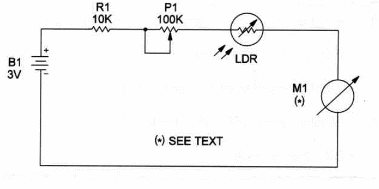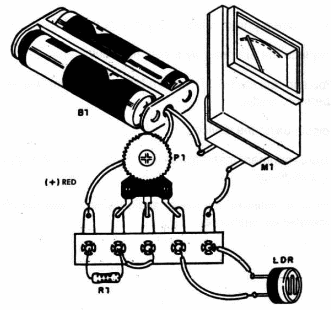Some of the most common applications for LDRs are as sensing elements in alarms, photo-relays, counters, light meters for photography and also experiments in optics.
The project described here is a simple light meter made from an LDR (Light Dependent Resistor or Photoresistor), a 0-200 µA microammeter, and a 3 V battery formed by two AA cells.
Use any general-purpose LDR with a high dark-to-light resistance ratio.
Since the circuit is operating for short durations you don’t need an ON-OFF switch.
Just put the cells in the battery holder when using the unit.
P1 adjusts sensitivity to the range of your working light intensity.
Figure 1 shows the schematic of the Photometer.

The ammeter is not critical.
Any type with full scale ranging from 100 µA to 1 mA can be used.
Figure 2 shows a mounting view, using a terminal strip as chassis.

The device can be housed in a small plastic box. The meter and LDR are placed on the front panel.
If the ammeter used is out of specification, you need to adjust P1. Try values between 10,000 and 100,000 Ω.
The LDR can be housed in a small opaque tube, depending on the application.
Photometer
LDR - Any common LDR (Light Dependent Resistor)
M1 - 0-200 µA - meter - see text
P1 - 100,000 ohm trimmer potentiometer
R1 - 10,000 ohm, ¼ W, 5% resistor
B1 - 3V - two AA cells
Ideas to Explore
To get better performance or to learn more about the circuit:
Try to use a phototransistor in place of the LDR.
Replace the ammeter by a common multimeter.
You can replace the LDFl by an NTC and convert the device into a temperature meter.
Science projects using the device:
Any experiment that involves light measurement can be conducted using this device.
You can calibrate the meter scale using a common photography photometer as reference.



